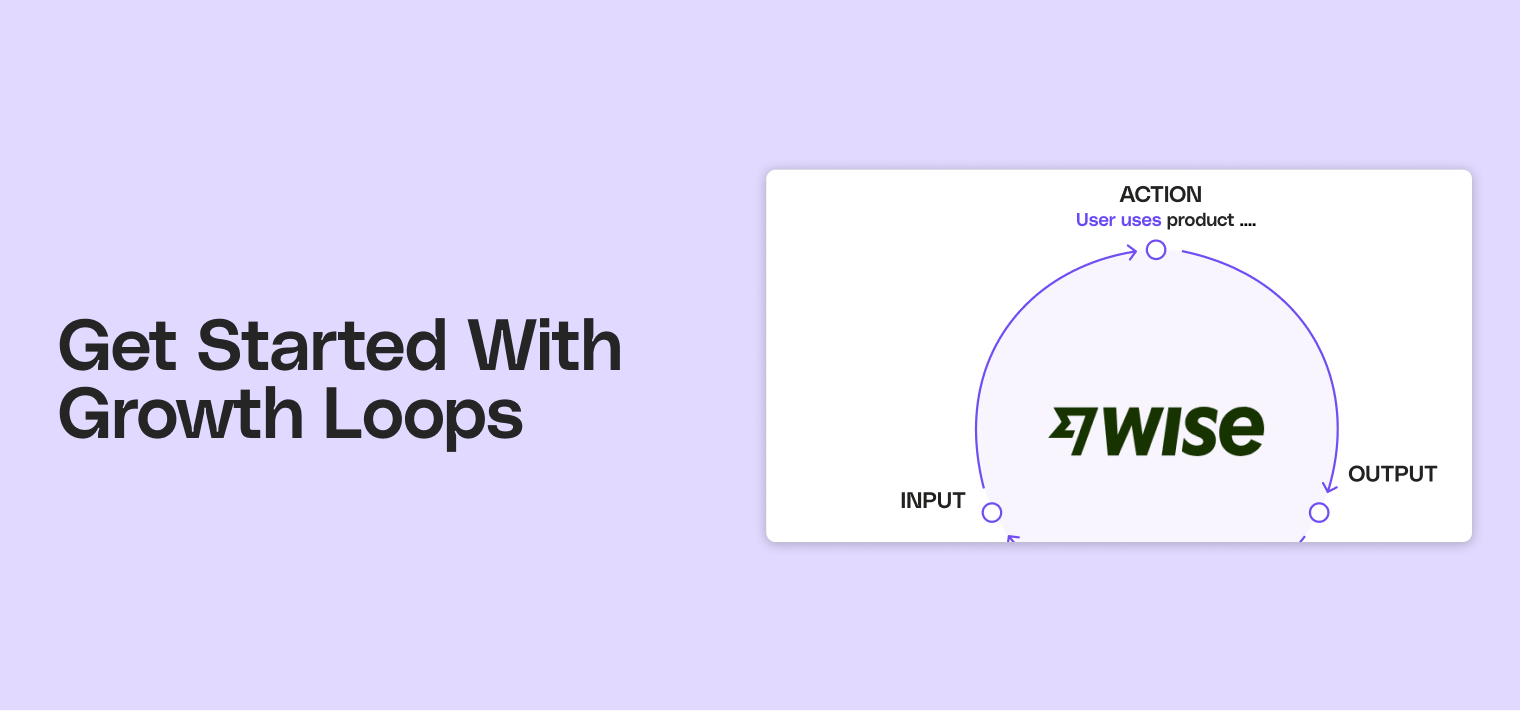Companies are constantly seeking innovative strategies to drive growth and stay ahead of the competition. Growth loops, a term coined by the Reforge team, have emerged as one of the most effective frameworks for building compounding product led growth. This article aims to explore the intricacies of growth loops, from their definition and importance to their various types and the steps involved in building one. Additionally, we will delve into measuring the success of growth loops through key performance indicators and interpreting growth loop data.
| Key Element | Description | Tips for Optimization |
|---|---|---|
| Understanding Growth Loops | Cyclical processes that attract and retain customers, driving sustainable growth. | Focus on continuous improvement through customer feedback and adaptation to market changes. |
| Key Components | Includes customer acquisition channels, user engagement mechanisms, retention tactics, and referral systems. | Align components with customer needs and preferences for better engagement and retention. |
| Functioning of Growth Loops | Starts with customer acquisition, followed by engagement, retention, and referrals. | Enhance each phase to improve overall loop effectiveness and customer satisfaction. |
| Types of Growth Loops | Includes Viral, Content, Paid, and Incentivized Growth Loops, each with specific strategies. | Select the type that best suits your business model and market environment. |
| Measuring Success | Utilize KPIs like customer acquisition cost, lifetime value, conversion rates, and referral metrics. | Regularly review and adjust KPIs to ensure alignment with business objectives and market conditions. |
Understanding the concept
Growth loops are a fundamental concept in the realm of business development and marketing. At their core, they are cyclical processes that enable companies to achieve sustainable and scalable growth. They are designed to attract new customers, retain existing ones, and create a virtuous cycle of continuous growth.
Definition and importance
📈🔁 Growth loops can be defined as a series of actions and mechanisms that drive customer acquisition, engagement, and retention. They involve leveraging feedback loops to improve the overall user or customer experience, thus fueling further growth.
Growth loops are crucial because they provide a structured framework that helps businesses to systematically analyze and optimize their growth strategies.
Role in business
Growth loops play a vital role in shaping the success and trajectory of businesses. By focusing on sustainable growth through customer retention and expansion, they enable companies to build a loyal customer base and achieve long-term profitability.
Moreover, growth loops foster innovation and encourage continuous experimentation, allowing businesses to adapt to evolving market dynamics efficiently.
The anatomy of a growth loop
To comprehend growth loops fully, it is essential to understand their key components and how they function. Let's dive into the intricacies that make up a growth loop.
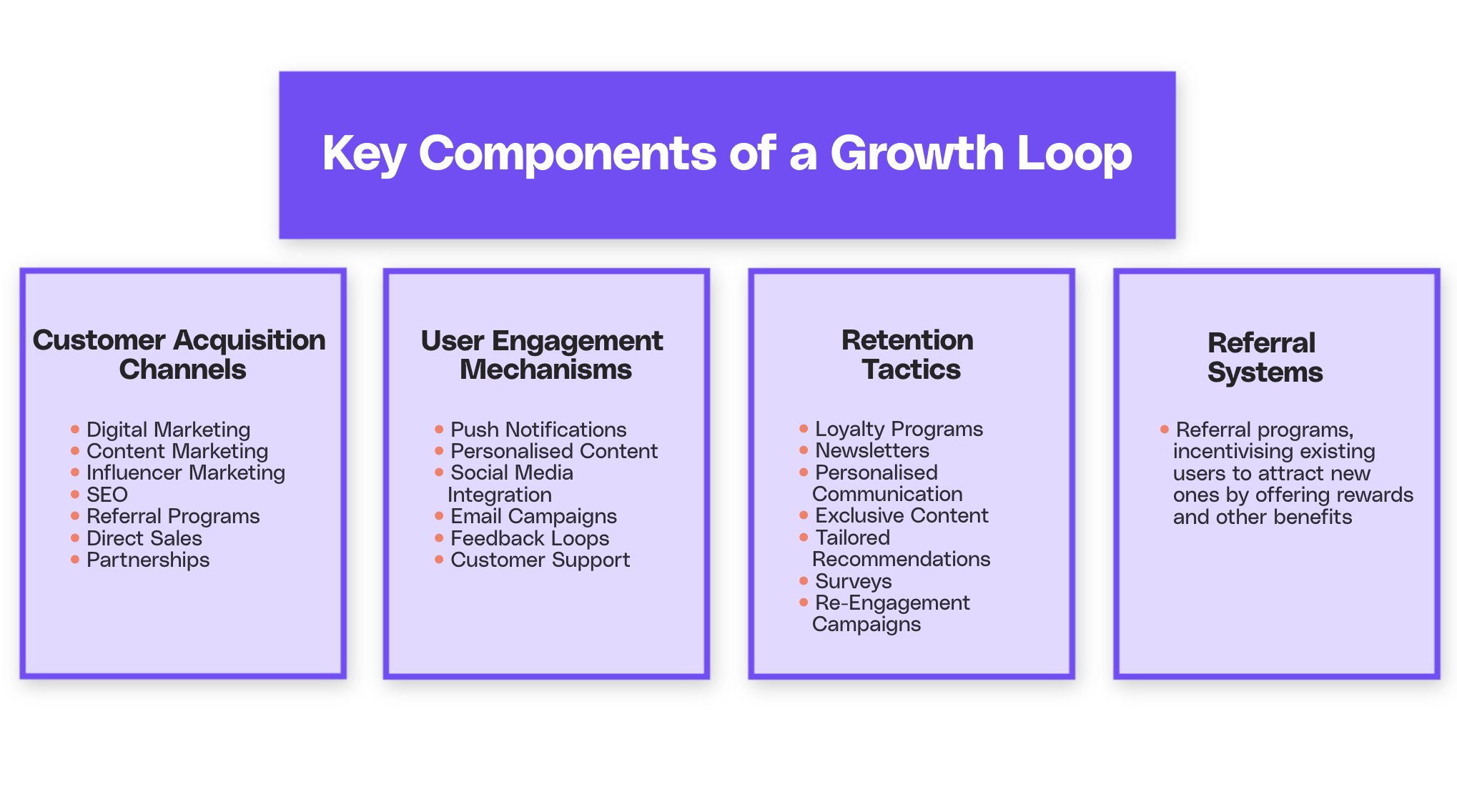
(Source: Cello)
Key components of a growth loop
A growth loop comprises several interrelated elements that work together to drive growth. These components typically include:
- Customer acquisition channels: These include digital, content, and influencer marketing, as well as Search Engine Optimisation (SEO), referral programs, direct sales, and partnerships.
- User engagement mechanisms: These include push notifications, personalised content, social media integration, email campaigns, feedback loops, and excellent chat support.
- Retention tactics: Some examples are loyalty programs, regular newsletters, personalised communication, exclusive content, tailored recommendations, surveys, and re-engagement campaigns.
- Referral systems: This entails a program employed by businesses to incentivise existing customers or users to recommend and attract new customers, typically by offering rewards or benefits for successful referrals.
Each of these components plays a crucial role in creating a self-perpetuating growth mechanism, ensuring the continuous expansion of a company's customer base.
How growth loops function
The functioning of growth loops can be summarized in a few key steps.
- Firstly, the loop starts with attracting potential customers through various marketing and acquisition channels.
- Once these customers are onboarded, the focus shifts to engaging them with the product or service, ensuring a positive user experience. This engagement leads to customer retention.
- Finally, satisfied customers become advocates who refer new customers, kickstarting the loop anew. The feedback generated from these customers allows for further optimization and improvement of the growth loop.
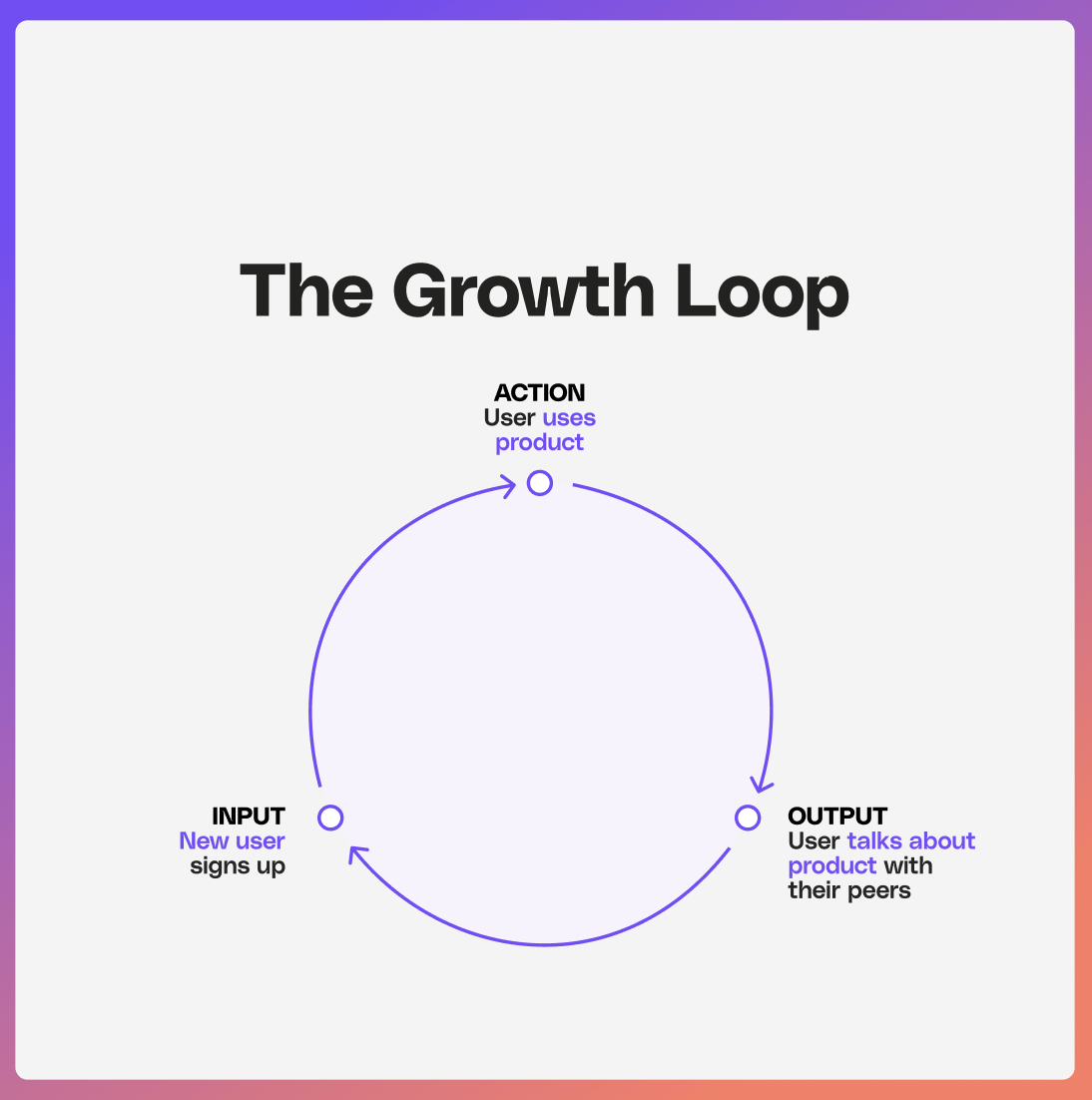
(Source: Cello)
Different types
There are various types of growth loops that businesses can employ based on their specific goals and target audience. Let's explore some of the most common ones.
Viral growth loops
Viral growth loops leverage the power of social sharing and referrals to drive exponential growth. By creating a product or service that encourages users to invite others to join, businesses can tap into the network effect and expand their customer base rapidly.
There are different types of viral loops:
- Word-of-Mouth (WOM): The epitome of virality occurs when users continuously discuss a product with their social circles. Achieving Word-of-Mouth (WOM) is the foundational level of virality, essential for establishing effective viral loops.
- Organic Viral Loops: These loops seamlessly integrate the invitation process into collaborative workflows and use cases of users, fostering natural and continuous growth.
- Casual Contact Loops: This type of loops are established when platforms strategically intertwine their features with user interactions, creating a chain reaction where each user action causally leads to the involvement of new users in a seamless and interconnected manner.

Content growth loops
Content growth loops rely on creating valuable and shareable content that attracts and engages users. This content can take various forms, such as blog articles, videos, podcasts, or interactive tools. When users find value in the content, they are more likely to share it with others, thus perpetuating the growth loop. Content growth loops include:
- Company-Generated Content Loops: These occur when a business strategically creates and shares content to maintain a continuous loop of audience interaction, brand visibility, and customer engagement in support of its marketing and growth strategies.
- User-Generated Content Loops: These loops entail the creation and sharing of content by users, contributing to a self-perpetuating cycle of community engagement, brand promotion, and organic growth. This enhances the overall experience and visibility of a product, service, or platform.
- Supplier-Generated Content Loops: This occurs when suppliers or vendors actively create and share content to promote their products or services. This may include product information, reviews, and promotional materials, and is disseminated to engage the target audience, strengthen brand presence, and foster a continuous loop of supplier-driven marketing efforts and growth.
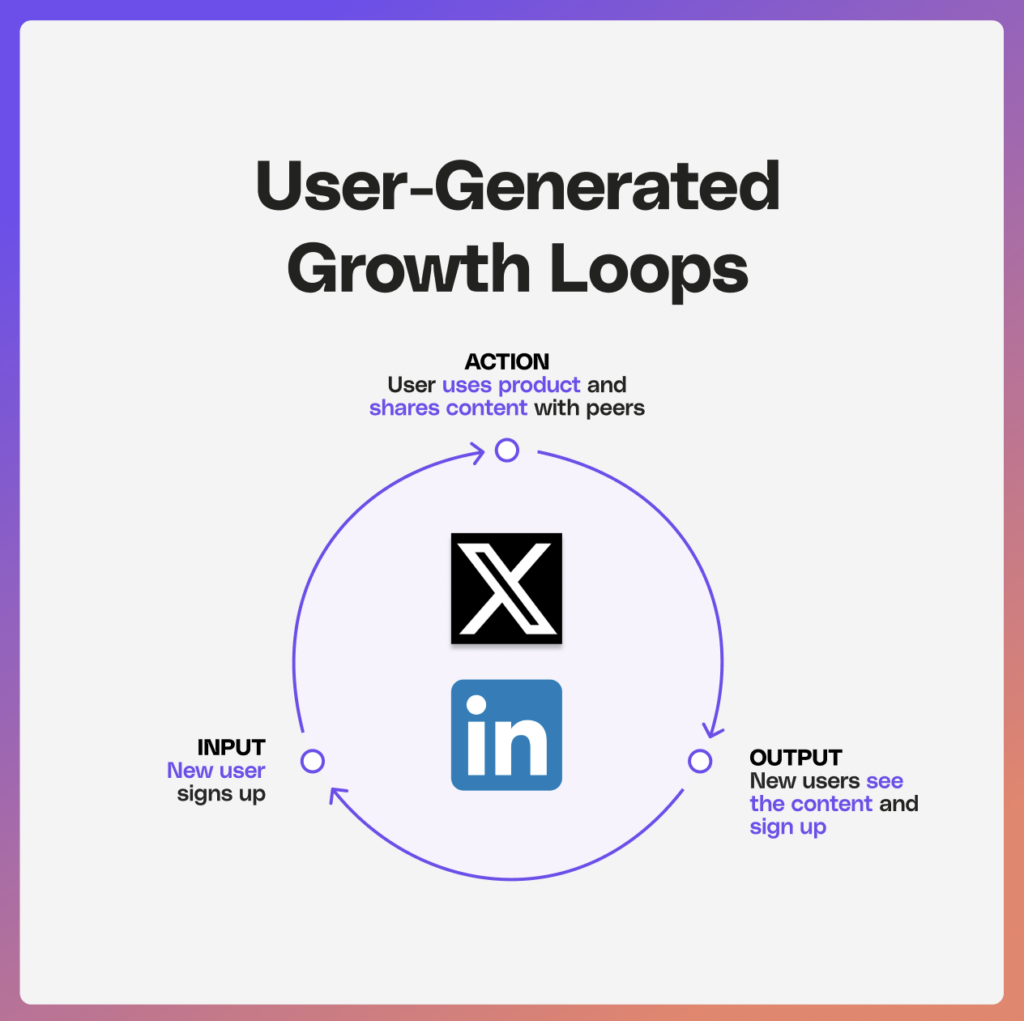
(Source: Cello)
Paid growth loops
Paid loops operate by generating revenue through the usage of the product, and subsequently, the earned funds are strategically reinvested to enhance features, marketing efforts, and user incentives, fostering a continuous cycle of attracting and retaining users.
They include:
- Sales Growth Loops: These revolve around providing an exceptional sales experience that converts customers into advocates. By prioritising customer satisfaction and offering exceptional post-sales support, businesses can foster customer loyalty and drive new customer acquisition through referrals and positive word-of-mouth.
- Ad Growth Loops: These loops involve reinvesting revenue generated from successful advertising efforts to continually expand the reach and impact of subsequent ad campaigns, creating a self-sustaining cycle for business growth.
- Integration Loops: This refers to strategic processes where the seamless incorporation of new features, technologies, or partnerships into a product or service is undertaken, often leading to enhanced functionality, increased user satisfaction, and a continuous cycle of integrating innovations for sustained improvement.

In this scenario, users are incentivized to actively participate and promote a product or service by receiving rewards, fostering a reciprocal relationship. This strategy encourages increased user engagement and facilitates organic growth, creating a cycle where both the users and the company benefit from enhanced visibility and usage. They include:
- Incentivized Word-of-Mouth Loops: These are designed to amplify product or service promotion through existing customers, offering them rewards for sharing their positive experiences and bringing in new customers.
- Incentivized Affiliate Loops: These focus on collaborating with external affiliates who are compensated for directing new customers to a business, typically through various digital platforms and networks.
- Incentivized User-Generated-Content Loops: These encourage customers to create and share content about a brand, rewarding them with incentives like discounts or exposure, which in turn enhances brand visibility and engagement.
- Incentivized Casual Contact Loops: These encourage companies or content creators to add a 'powered by' label when using a product, thereby increasing casual interactions by users and driving visibility, engagement, and sales.

(Source: Cello)
Building your own loop
Now that we have explored the different types of growth loops, it's time to understand the steps involved in building your own.
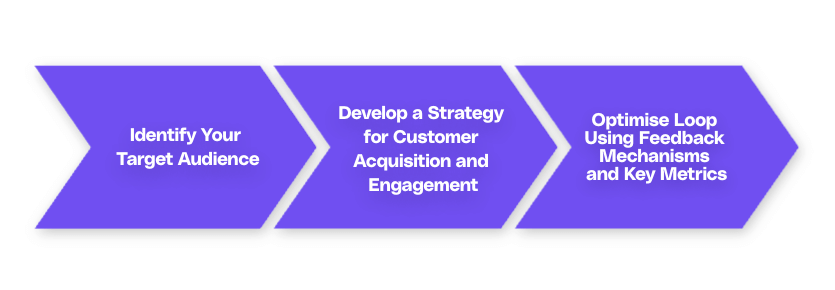
(Source: Cello)
Steps to create a growth loop
Creating an effective growth loop requires careful planning and execution.
- The first step is to identify your target audience and understand their needs and pain points. Once you have a clear understanding of your customer base, you can design a product or service that addresses these needs.
- Next, you need to develop a strategy for customer acquisition and engagement, leveraging channels and mechanisms that resonate with your target audience.
- Additionally, incorporating feedback mechanisms and monitoring key metrics will allow you to continually optimise your growth loop for maximum impact.
Common challenges and solutions in growth loop creation
While building a growth loop can be immensely rewarding, it also comes with its fair share of challenges, including:
- Data: Understanding and analyzing the vast amount of data generated by the loop can be challenging. To overcome this, businesses can utilize data analytics tools to gain insights and uncover patterns that fuel growth.
- User Experience: Businesses struggle ensuring a consistent and seamless user experience throughout the loop. By investing in user-centric design and actively seeking user feedback, businesses can address this challenge and create a compelling growth loop.
Measuring success
After building a growth loop, it is essential to monitor its performance and measure its success. This can be achieved through the effective use of key performance indicators (KPIs) and diligent data analysis.
Key performance indicators
Determining the right KPIs is crucial for evaluating the effectiveness of a growth loop. Some common KPIs include:
- Customer acquisition cost
- Customer lifetime value
- Conversion rates
- Referral metrics
These indicators provide valuable insights into the performance of different components within the growth loop, enabling businesses to make data-driven decisions and optimize their strategies.
Interpreting growth loop data
Effective data interpretation is key to transforming raw metrics into actionable insights. By systematically analyzing growth loop data, businesses can uncover patterns, identify bottlenecks, and discover opportunities for improvement.
This data-driven approach enables businesses to refine their growth loop and yield greater results.In conclusion, growth loops represent a powerful strategy for achieving sustainable and scalable growth. By understanding the basics, key components, and different types, businesses can embark on the journey of building their own growth loops.
Through careful planning, addressing challenges, and measuring success using relevant KPIs, businesses can create a self-perpetuating growth mechanism that propels them into the future. So, embrace the concept of growth loops and unlock the full potential of your business.
Unlock your business's viral potential with Cello
Ready to transform your users into a powerful engine for sustainable growth? Cello is here to help you capitalize on the strategies discussed by seamlessly integrating a peer-to-peer referral program into your SaaS product. With minimal development time, immediate payback, and impressive conversion rates, Cello makes it effortless to launch a user-led growth channel. Experience a user-friendly platform that integrates with your existing tools and automates rewards, all while ensuring compliance and security. Don't miss out on the opportunity to see how Cello can amplify your growth loops. Book a demo today and start turning your users into your most valuable growth channel.
Resources
Related Articles

7 Best B2B Referral Software (2025 Guide)
Which referral software should I choose? In the world of referral marketing, choosing the right ...

Scaling and Maintaining a B2B User Referral Program
Learn how to set the right incentives for B2B SaaS user referral programs
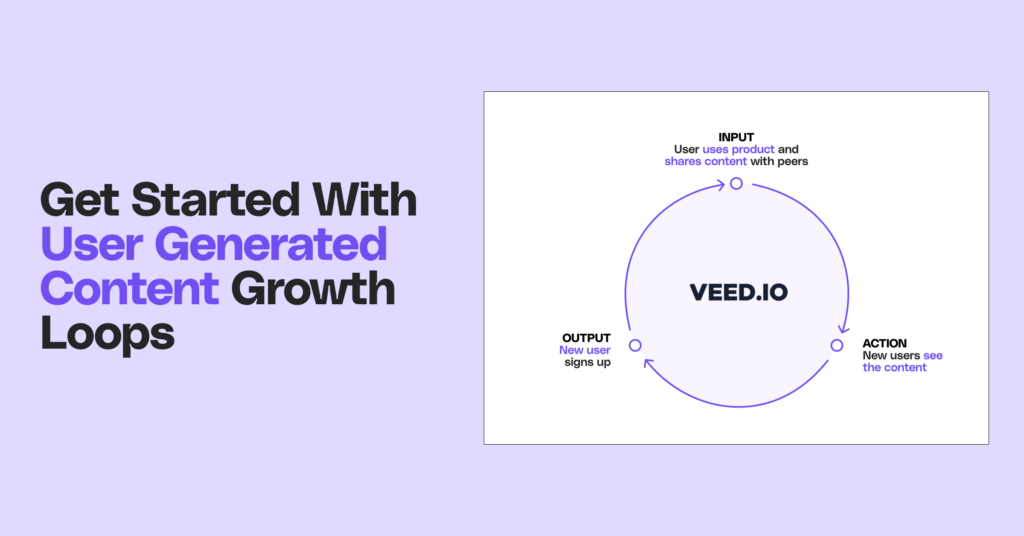
What are User Generated Content Growth Loops?
User Generated Growth (UGC) loop is a growth engine where users create content that attracts ...
